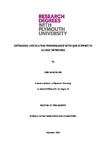OPTIMISING APPLICATION PERFORMANCE WITH QOS SUPPORT IN AD HOC NETWORKS
| dc.contributor.supervisor | Ghita, Bogdan | |
| dc.contributor.author | Marchang, Jims | |
| dc.contributor.other | School of Engineering, Computing and Mathematics | en_US |
| dc.date.accessioned | 2016-12-22T15:29:50Z | |
| dc.date.available | 2016-12-22T15:29:50Z | |
| dc.date.issued | 2016 | |
| dc.identifier | 10407181 | en_US |
| dc.identifier.uri | http://hdl.handle.net/10026.1/8167 | |
| dc.description.abstract |
The popularity of wireless communication has increased substantially over the last decade, due to mobility support, flexibility and ease of deployment. Among next generation of mobile communication technologies, Ad Hoc networking plays an important role, since it can stand alone as private network, become a part of public network, either for general use or as part of disaster management scenarios. The performance of multihop Ad Hoc networks is heavily affected by interference, mobility, limited shared bandwidth, battery life, error rate of wireless media, and the presence of hidden and exposed terminals. The scheduler and the Medium Access Control (MAC) play a vital role in providing Quality of Service (QoS) and policing delay, end-to-end throughput, jitter, and fairness for user application services. This project aims to optimise the usage of the available limited resources in terms of battery life and bandwidth, in order to reduce packet delivery time and interference, enhance fairness, as well as increase the end-to-end throughput, and increase the overall network performance. The end-to-end throughput of an Ad Hoc network decays rapidly as the hop count between the source and destination pair increases and additional flows injected along the path of an existing flow affects the flows arriving from further away; in order to address this problem, the thesis proposes a Hop Based Dynamic Fair Scheduler that prioritises flows subject to the hop count of frames, leading to a 10% increase in fairness when compared to a IEEE 802.11b with single queue. Another mechanism to improve network performance in high congestion scenarios is network-aware queuing that reduces loss and improve the end-to-end throughput of the communicating nodes, using a medium access control method, named Dynamic Queue Utilisation Based Medium Access Control (DQUB-MAC). This MAC provides higher access probability to the nodes with congested queue, so that data generated at a high rate can be forwarded more effectively. Finally, the DQUB-MAC is modified to take account of hop count and a new MAC called Queue Utilisation with Hop Based Enhanced Arbitrary Inter Frame Spacing (QU-EAIFS) is also designed in this thesis. Validation tests in a long chain topology demonstrate that DQUB-MAC and QU-EAIFS increase the performance of the network during saturation by 35% and 40% respectively compared to IEEE 802.11b. High transmission power leads to greater interference and represents a significant challenge for Ad Hoc networks, particularly in the context of shared bandwidth and limited battery life. The thesis proposes two power control mechanisms that also employ a random backoff value directly proportional to the number of the active contending neighbours. The first mechanism, named Location Based Transmission using a Neighbour Aware with Optimised EIFS for Ad Hoc Networks (LBT-NA with Optimised EIFS MAC), controls the transmission power by exchanging location information between the communicating nodes in order to provide better fairness through a dynamic EIFS based on the overheard packet length. In a random topology, with randomly placed source and destination nodes, the performance gain of the proposed MAC over IEEE 802.11b ranges from approximately 3% to above 90% and the fairness index improved significantly. Further, the transmission power is directly proportional to the distance of communication. So, the performance is high and the durability of the nodes increases compared to a fixed transmission power MAC such as IEEE 802.11b when communicating distance is shorter. However, the mechanism requires positional information, therefore, given that location is typically unavailable, a more feasible power control cross layered system called Dynamic Neighbour Aware – Power controlled MAC (Dynamic NA -PMAC)is designed to adjust the transmission power by estimating the communicating distance based on the estimated overheard signal strength. In summary, the thesis proposes a number of mechanisms that improve the fairness amongst the competing flows, increase the end-to-end throughput, decrease the delay, reduce the transmission power in Ad Hoc environments and substantially increase the overall performance of the network. | en_US |
| dc.language.iso | en | |
| dc.publisher | University of Plymouth | |
| dc.rights | Attribution 3.0 United States | * |
| dc.rights.uri | http://creativecommons.org/licenses/by/3.0/us/ | * |
| dc.subject | ad hoc networks | en_US |
| dc.subject | MAC | en_US |
| dc.subject | QoS support | en_US |
| dc.subject | scheduler | en_US |
| dc.subject | power control transmission | en_US |
| dc.subject.classification | PhD | en_US |
| dc.title | OPTIMISING APPLICATION PERFORMANCE WITH QOS SUPPORT IN AD HOC NETWORKS | en_US |
| dc.type | Thesis | |
| plymouth.version | publishable | en_US |
| dc.identifier.doi | http://dx.doi.org/10.24382/1087 | |
| dc.rights.embargoperiod | No embargo | en_US |
| dc.type.qualification | Doctorate | en_US |
| rioxxterms.funder | Not available | en_US |
| rioxxterms.identifier.project | Not available | en_US |
| rioxxterms.version | NA |
Files in this item
This item appears in the following Collection(s)
-
01 Research Theses Main Collection
Research Theses Main



